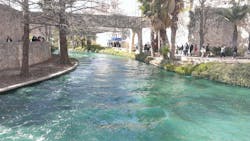San Antonio River Authority Develops Green Storm Water Infrastructure Plan
Yu-Chun Su, Ph.D., P.E., CFM, CPESC, CPSWQ, is the Environmental and Water Resources Engineering Director at Lockwood, Andrews & Newnam, Inc. He can be reached at [email protected]; Ka Leung Lee, Ph.D., P.E., CFM, CPSWQ, is a Senior Stormwater Engineer at Lockwood, Andrews & Newnam, Inc. He can be reached at [email protected]; Michelle E. Garza is a Stormwater Analyst, Sustainable Infrastructure Unit, at San Antonio River Authority. She can be reached at [email protected]; Sheeba M Thomas, Ph.D., P.E., PMP, CFM, is a Senior Technical Engineer at San Antonio River Authority. She can be reached at [email protected]; and Faith Hambleton is a Team Leader, Nonpoint Source Program, at Texas Commission on Environmental Quality. She can be reached at [email protected].
undefinedIn 2019, the San Antonio River Authority (River Authority) was awarded a Clean Water Act Section 319(h) Grant by the U.S. Environmental Protection Agency, administered by the Texas Commission on Environmental Quality (TCEQ), to develop a master plan for the use of green storm water infrastructure (GSI). This three-year grant project builds off recommendations made in the Upper San Antonio River (USAR) Watershed Protection Plan to implement GSI to reduce storm water runoff pollution and addresses measures in the Texas Non-Point Source Management Program.
In the past, most storm water infrastructure was designed to manage storm water volume and address flooding issues with little or no focus on managing storm water quality. However, urbanization of a watershed not only increases storm water runoff resulting in flooding concerns, but also increases pollutant loads resulting in degraded water quality that impacts aquatic life as well as water supply and recreation.
GSI are constructed features that add the storm water quality component to storm water infrastructure by mimicking the predevelopment hydrology of a drainage area and reduce pollutant loads. Example GSI features evaluated in this project include bioretention basins, bioswales and extended detention basins. They are designed to reduce storm water loads by capturing and treating a portion of storm water runoff pollution and therefore reducing the loads entering local creeks and rivers.
With GSI being relatively new to the San Antonio River Basin, the River Authority worked with Lockwood, Andrews & Newnam, Inc. (LAN), a national planning, engineering and program management firm, on modeling potential GSI to evaluate their performance in reducing pollutant loads. The results support the River Authority’s Master Plan development that aims to guide decision-makers on where and how to apply limited resources in the upcoming years to maximize water quality benefits while addressing local flooding concerns.
Start with High Priority Subbasins
The River Authority and LAN previously developed subbasin-scale hydrologic and water quality models using the Hydrologic Simulation Program – Fortran (HSPF) model to identify high priority subbasins with the highest storm water pollutant load reduction potential. The modeled constituents included E. coli bacteria, water temperature, dissolved oxygen, carbonaceous biochemical oxygen demand, nitrate nitrogen, ammonia nitrogen, organic nitrogen, total phosphorus, orthophosphorus and total suspended solids. The target constituent is E. coli bacteria, which has water quality standards to support contact recreation activities, such as swimming. The HSPF model included a simulation period from 2007 to 2010.
These previously developed models were modified for the GSI project to allow site-scale modeling. To identify and prioritize potential sites that have the highest potential for GSI implementation effectiveness, the River Authority considered properties including public lands, schools, capital improvement projects, city planning areas and neighborhoods with supportive stakeholders such as homeowner’s association partners.
The River Authority identified eight high-priority areas of significant storm water loading for GSI opportunities, costs of those opportunities and GSI prioritization. A best management practice (BMP) ranking and performance evaluation HSPF modeling was conducted following a Quality Assurance Project Plan (QAPP), which was developed for the project and approved by TCEQ to ensure the quality of the effort.
Within each of the eight high-priority subbasins, the River Authority conducted site evaluation using Geographic Information System (GIS) to identify several potential BMP sites. To assist with the selection of BMP sites most suitable for modeling and performance evaluation, LAN developed a BMP ranking matrix. This ranking matrix is the first of its kind in San Antonio and helped with the evaluation and selection of BMP sites within a subbasin. The BMP ranking matrix assigned scores to key factors, such as drainage area, land uses, BMP footprint area, receiving water, BMP types, shading, location of BMP site within a subbasin, hydrologic soil group, area in floodplain X and AE zones (the 500- and 100-year floodplains, respectively), etc. Each score in the matrix is multiplied by a weighing factor when calculating the overall score. The default value of the weighing factors is 1.0, and users can adjust the value. The matrix helped prioritize and provided justification for the final selection of BMP sites.
The analysis and modeling effort involved developing conceptual GSI designs at eight selected subbasins within the USAR Watershed with one GSI site per subbasin. The previously developed and calibrated subbasin-scale HSPF model was refined to perform site-scale water quality modeling at each of these eight GSI sites to evaluate BMP performance.
When laying out BMPs and conducting the GSI modeling, the City of San Antonio’s Unified Development Code or UDC was followed when determining the required water quality volume (WQV) to be captured and treated by a BMP. The project team also selected BMP types from the San Antonio River Basin Low Impact Development Technical Design Guidance Manual, Second Edition, May 2019. Within each GSI site, large trees were preserved because they already helped with storm water quality. Existing park facilities were also preserved to maintain recreational functions. The selected BMP footprint areas were checked to ensure they were outside of the effective 100-year floodplain. The percentage removal of modeled constituents for each BMP type was obtained from the SARA Enhanced BMP Tool Database.
Total Pollutant Reduction Estimated
A continuous simulation of the site-scale HSPF models was performed for the period from 01/01/2007 to 12/31/2010. The outputs from the continuous simulation were used to estimate annual average load removal at each BMP site and the effectiveness of each modeled BMP type in reducing constituent loads.
The workplan for site-scale modeling of the QAPP called for specifying the retention capacity, inflow rate capacity, flow-through rate capacity and load reduction of the BMPs. The estimated pollutant load reductions for E. coli bacteria and nutrients that these projects would achieve across the watershed can be found in the GSI Master Plan.
Stakeholder Engagement
The River Authority incorporated stakeholder input from property owners, operators and community groups to identify common goals, investment priorities, stakeholder needs and stakeholder restrictions for implementing GSI. This outreach was conducted virtually during the COVID pandemic, utilizing online platforms, yard signs and flyers to ensure maximum participation. The River Authority engaged stakeholders throughout the project area with workshop materials posted on the project website. Five community workshops were conducted between February and May 2021, to share results with numerous stakeholders, including local government partners, a community located in a high-priority source area, and private industry professional groups.
Triple Bottom Line Cost/Benefit Analysis
Once the site’s GSI BMP pollutant reduction ability was established, and construction and operation and maintenance costs were estimated, a Triple Bottom Line (TBL) analysis was conducted to monetize the costs and benefits of activities in three functions: economic, social, and environmental. Leveraging the GSI BMP modeling data, as well as peer reviewed literature and government reports, the River Authority and its subcontractor, Autocase, analyzed and compared the TBL benefits between the base case and design scenarios. A summary of these outcomes are can be found in the GSI Master Plan. They are all relative to the existing conditions at the site locations or 'base case' that assumes a managed turf land cover.
Some of the project sites resulted in a negative Triple Bottom Line-Net Present Value (TBL-NPV), while some returned positive results. The largest negative TBL-NPV driver was financial impacts from higher upfront capital costs and operations and maintenance costs. Shifting away from managed landscape practices enabled multiple benefits to accrue to the environment in the form of improved water quality, reduced trash in local waters, greater vegetative sequestration, and a more conducive habitat for pollinators. The TBL analysis helped communicate the additional benefits of installing GSI over the lifetime of a project in present day values.
Conclusion & Path Forward
The GSI Master Plan – the first of its kind – was developed with implementation recommendations based on the analysis of existing data and additional modeling to identify high priority source areas of significant loading and transport of nonpoint source pollutants, GSI opportunities, costs of those opportunities, and GSI prioritization. Activities prioritized in the GSI Master Plan were based on criteria including assessment of stakeholder process, project implementation, programmatic findings, funding, and implementation schedule.
The developed GSI Master Plan also includes a recommended schedule of implementation, the stakeholder process, estimated costs, funding considerations, and the overall evaluation and prioritization process. The outcome serves as examples for communities to use for their own decision-making.
In the coming years, the goal is to use the master plan as a template to select and implement GSI in all sub-basins that do not meet water quality standards in the San Antonio River Basin.
For more information on the GSI Master Plan please visit the project webpage.
Acknowledgement
PREPARED IN COOPERATION WITH THE TEXAS COMMISSION ON ENVIRONMENTAL QUALITY AND U.S. ENVIRONMENTAL PROTECTION AGENCY
This project has been funded wholly or in part by the United States Environmental Protection Agency under assistance agreement (99614623) to the Texas Commission on Environmental Quality. The contents of this document do not necessarily reflect the views and policies of the Environmental Protection Agency, nor does the EPA endorse trade names or recommend the use of commercial products mentioned in this document.


